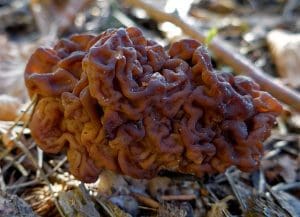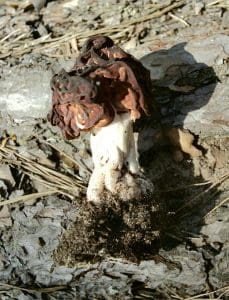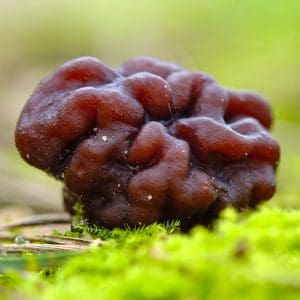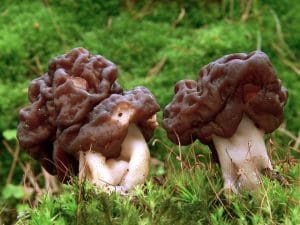False Morel / Spring / Toxic
Enter a realm of danger as we unveil the sinister truth about the False Morel (Gyromitra esculenta), a mushroom that demands utmost caution.
Join us on a journey where deception and toxicity intertwine. With its intricate brain-like appearance and earthy allure, the False Morel tempts the unsuspecting forager. However, beneath its enticing exterior lies a grave danger. Discover the distinct characteristics that differentiate it from its edible counterpart, explore its preferred habitats, and understand the hazardous toxins it harbors.
Safety and knowledge are paramount when dealing with this mushroom, as consumption can lead to severe health complications. Take heed of the warnings and avoid the allure of the False Morel. Let this serve as a reminder of the importance of accurate identification, responsible foraging practices, and the preservation of one’s well-being. Respect the perils that nature presents and navigate the world of mushrooms with informed caution.
Scientific Name
Gyromitra esculenta
Common Names
False Morel, Turban fungus
Family
Discinaceae
Habitat
They are mostly found at altitude in coniferous forests, occasionally they can be found on lower lying ground.
Description
They contain gyromitrin, an organic carcinogenic poison and are known to be deadly poisonous when raw, as their common name suggests they can be mistaken for edible Morels (Morchella) so care should be taken.
Identifying Features:
Cap:
The caps are very wrinkled and resemble a brain, they can be up to 12cm across. Brown to orange brown in colour. Inside there are many small, hollow cavities.

Stem:
The stem is up to 5 cm tall, white to cream in colour and fragile.

Gills:
They lack gills.
Smell:
No strong aroma.
Spores:
Yellow to buff.
Known hazards
They are potential deadly poisonous, symptoms can include nausea, vomiting, abdominal pain, diarrhoea, dizziness, headache, muscle cramps, bloating, confusion, delirium, seizures and coma. The main toxin is called gyrotoxin, exactly how it effects humans is not clear but it somehow destroys red blood cells it is also carcinogenic.
Potential lookalikes
As the common name suggest they do look like the true Morel (Morchella elata).
This mushroom has deeper pits and has a longer stem. The main difference is when they are both cut in half. The False Morel has a series of hollow chambers whereas the True Morel has one hollow space extending from the cap to the stem.
Extra Notes
The genus name Gyromitra comes from the Greek word for round, gyro and mitra meaning head band. Esculenta comes from the Latin word for edible and its a bit of a misnomer.
Resources
https://www.first-nature.com/fungi/gyromitra-esculenta.php
https://www.ncbi.nlm.nih.gov/books/NBK470580/
https://www.michigan.gov/mdhhs/0,5885,7-339-73970_71692_8347-256874–,00.html








Leave a Reply
You must be logged in to post a comment.